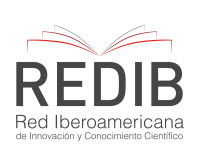Peronism and spectacle (1949-1951). The División de Acción Radial developing and its political intervention.
Keywords:
Peronism, Radio, Hegemony, Propaganda, Spectacle.Abstract
This article studies how the radio propaganda developed by the Peronism government intervened in the political struggel. Since the formation of the División de Acción Radial, part of the Subsecretaría de Informaciones, multiple auditions took place as an integral part in the construction of hegemony. For this reason, the operation of this state agency is described, as well as the different formats developed by it, during the period of 1949 and 1951. This period begins with the government taking ownership of all radio stations and ends with the electoral campaign to re-elect Perón as president. This article uses concepts from media studies, culture, society and politics, with premises that have their origin in the Sociology of Culture, as well as in Cultural History and Media History. For its realization various archives were consulted such as the Departamento de cine, audio y video, as well as the Fondo Fiscalía Nacional de Recuperación Patrimonial, Comisión 21 “Secretaría de Prensa y Difusión”, both from the Archivo General de la Nación. It was also consulted spectacle magazines and newspapers of that period. On one hand the results of this study displays that the radio propaganda of Peronism, used the fictional radio genres for political communication; on the other hand, agents from the entertainment field were constantly summoned for their development. It is proposed that this appeal to the spectacle was not only effective in the political construction of Peronism, but also became a key element of its cultural matrix.
Downloads
References
Gené, Marcela. Un mundo feliz: imágenes de los trabajadores en el primer peronismo 1946-1955. Buenos Aires: FCE. 2005. Impreso.
Gerchunoff, P. La caída. 1955. Buenos Aires: Crítica. 2018. Impreso.
Invernizzi, Hernán. Cines rigurosamente vigilados. Censura peronista y antiperonista, 1946-1976. Buenos Aires: Capital Intelectual. 2014. Impreso.
Kabat, Marina. PerónLeaks. Una re-lectura del peronismo a partir de sus documentos secretos, 1943-1955. Buenos Aires, Ediciones R y R. 2017. Impreso.
Kriger, Clara. Cine y peronismo: el estado en escena. Buenos Aires: Siglo XXI. 2009. Impreso.
Lindenboim, Federico. “Ensayo general: la radio durante el gobierno militar de 1943”. X Jornadas de Sociología de UNLP, 5, 6 y 7 de diciembre de 2018, Departamento de Sociología de la Facultad de Humanidades y Ciencias de la Educación (UNLP). 2018. Mimeo.
Lindenboim, Federico. “La disputa por la radio. Gobierno, gremios y espectáculo en los inicios del peronismo (1943-1946)”. En La Trama de la Comunicación, volumen 24, (Nº 2, julio-diciembre 2020). mimeo.
Maase, Kaspar. Diversión ilimitada. El auge de la cultura de masas (1850-1970). Madrid: Siglo XXI, 2016. Impreso.
Maragnhello, César. Artistas Argentinos Asociados: la epopeya trunca. Buenos Aires: Ediciones del Jilguero, 2002. Impreso.
Matallana, Andrea. ‘Locos por la radio’. Una historia social de la radiofonía en la Argentina, 1923-1947. Buenos Aires: Prometeo. 2006. Impreso.
Mercado, Silvia. El inventor del peronismo. Raúl Apold, el cerebro oculto que cambió la política argentina. Buenos Aires: Planeta. 2013. Impreso.
Plotkin, Mariano. Mañana es San Perón: propaganda, rituales políticos y educación en el régimen peronista (1946-1955). Buenos Aires: Eduntref.1994, [2013]. Impreso.
Pujol, Sergio. Discépolo. Una biografía argentina. Buenos Aires: Planeta. 2017. Impreso.
Pulfer, Dario. Escritores ‘malditos’: peronismo histórico y campo intelectual en una aproximación de Jauretche. Buenos Aires: Peronlibros. 2015. Impreso.
Rougier, Marcelo. La economía del peronismo. Una perspectiva histórica. Buenos Aires: Sudamericana. 2012. Impreso.
Sirvén, Pablo. Perón y los medios de comunicación (1943-1955). Buenos Aires: Centro Editor de América Latina. 1984. Impreso.
Tarde, Gabriel. Creenc ias, deseos, sociedades. Buenos Aires: Cactus. 2011. Impreso.
Welch, David. Propaganda and the German cinema, 1933-1945. Londres: I. B. Tauris. 1983, [2001]. Impreso.
Welch, David. The Third Reich. Politics and propaganda. Nueva York: Routledge. 1993, [2002]. Impreso.
Williams, Raymond. “Introducción”. En Williams, R. (ed.), Historia de la comunicación. Volumen I: del lenguaje a la escritura. Barcelona: Bosch. 1992. Impreso.
Documentos
Apold, Raúl (1953) Coordinación de la difusión, propaganda y contrapropaganda sobre acción política. Subsecretaría de Informaciones, Buenos Aires, abril de 1953.
Colección personal de Daniel Luirette.
Archivo General de la Nación, Departamento de Archivo Intermedio y Departamento Cine, Audio y Video. Fondo Fiscalía Nacional de Recuperación Patrimonial, Comisión 21 “Secretaría de Prensa y Difusión”.
INDEC (1947). IV Censo General de la Nación. Edificación y Vivienda. Mimeo.
Revistas
Sintonía
Antena
Radiolandia
Downloads
Published
How to Cite
Issue
Section
License
Nota del Copyright
Los trabajos presentados en Revista Pilquen, Sección Ciencias Sociales deben ser originales e inéditos y no estar postulados simultáneamente en otras revistas. El envío de todo tipo de colaboración implica la aceptación de las normas editoriales de la revista y la autorización al Comité Editorial para que difunda los trabajos tanto en la revista como en las bases de datos o sistemas de indización en donde se alojan los contenidos de Pilquen.
Las y los autores que publican en esta revista están de acuerdo con los siguientes términos:
1) Las autoras y los autores conservan los derechos de autor y garantizan a la revista el derecho de ser la primera publicación del trabajo al igual que licenciado bajo una Creative Commons "Atribución -No Comercial CC BY-NC-SA”, mediante la cual ser permite copiar, reproducir, distribuir, comunicar públicamente la obra y generar obras derivadas, siempre y cuando se cite y reconozca al autor original. No se permite, sin embargo, utilizar la obra ni sus posibles obras derivadas con fines comerciales.
2) Las y los autores pueden establecer por separado acuerdos adicionales para la distribución no exclusiva de la versión de la obra publicada en la revista (por ejemplo, situarlo en un repositorio institucional o publicarlo en un libro), con un reconocimiento de su publicación inicial en esta revista.
3) Las y los autores no recibirán compensación monetaria de Pilquen por el uso del material contenido en el artículo; así como tampoco asumirán ningún costo de publicación de los mismos.












